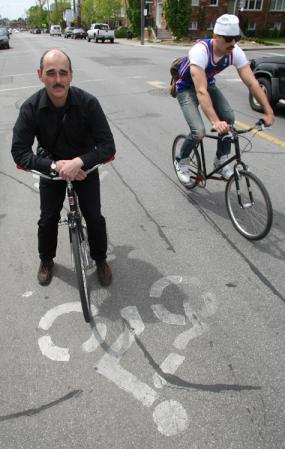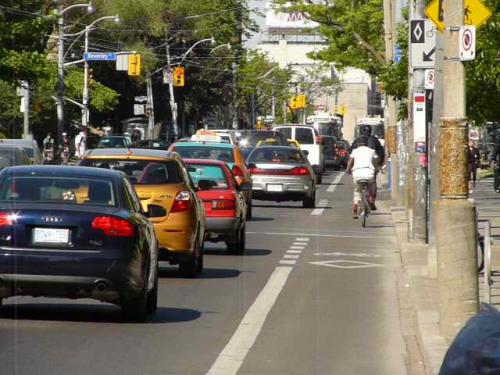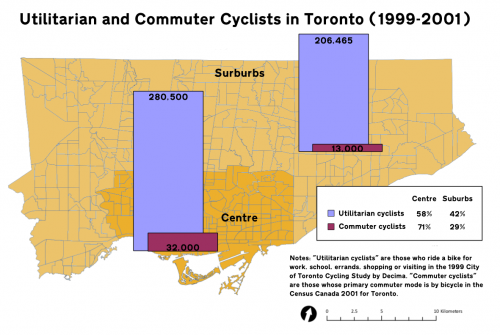There’s a feeling “out there” that because motorists pay “user fees” for licences and registration as well gas taxes and insurance, that they somehow have more “rights” to the road than everybody else. And that because motorists pay for those things, somehow motorists are more “responsible” that the rest of society which includes lowly cyclists.
Let’s dispel a myth today. It is my assertion that motorists are, in fact, acting much less responsible than they claim, and further, that they are to blame for a lessened quality of our public spaces.
First off, there are plenty of articles about who pays for the roads, including articles on this very blog. I’ll refer the reader there to read these entries, and I won't bother repeating those arguments.
My copy of the driver’s handbook, copyright 2007, has written in the second paragraph of Chapter 1 that would be motorists “have to pass a test” for “driving privileges.” What this means is that everybody has the same and equal right to share the road, but licensed drivers have the privilege of doing so with an insured and registered motor vehicle. That’s all. Somewhere along the way many seemed to have forgotten this.
Licensing fees and registration fees pay are set to cover the service to provide licensing and registration -- barely. Toronto residents who own a car pay an additional tax on top of our vehicle registration, one which raises about $90 million to offset the almost $300 million operating costs and the approximately $360 million in annual capital costs in Toronto’s budget this year. That car drivers finally have to ante up and pay additional fees for the extra wear-and-tear that their heavy vehicles place on our roads is only fair, but does not grant them and additional privilege or rights.
Let’s talk about motorist’s feeling that they’re responsible citizens. There’s an old adage that “Insurance is expensive, until you have to use it.” All motorists are required to have insurance to driver a motor vehicle. The reality is that motorists crash. Because of the strength and weight of their vehicles, they cause extensive and major damage which is usually expensive to repair and/or replace. Carnage is an apt term. Motorists crash into each other, into buildings, signs, poles, trees, barriers, pedestrians, cyclists, all manner of animals (wild and domestic) and everything else that happens to be on, or near, any surface that can be driven on.
It’s sad enough we tolerate animal road-kill. But now motorists treat human victims the same way. Motorists inflict other people with injuries, and then leave the victims to lick their own wounds by making the victims cover their own costs for recovery. Besides the rise of hit-and-run collisions, even when a motorist does stay to face the pathetically low penalties for their negligence, their insurance does not cover the costs to their victims. This means that humans are being treated in a manner similar to road-kill in order to help keep insurance premiums low. Victims of car crashes are subsiding the bad behaviour driver’s exhibit on our streets, and drivers are further subsidizing the worst drivers and keeping them on the road; all in the name of “cheaper insurance.” The scam, the fraud, is not “of the system” but the fraud is the system itself. The Insurance industry refuses to cover the costs they are being paid to cover, and governments are complicit because the insurance industry knows that a government will fall when they don’t keep insurance rates down.
Pedestrians and cyclists cannot cover themselves with supplemental insurance; insurance companies don’t offer this service. Our province won’t mandate it because it would mean recognising the shortfall that they themselves created in our current "the victim pays" insurance system.
Because motorists systemically treat their fellow humans like road kill illustrates how motorists are abdicating their responsibility. These are not responsible people; motorists are people who shirk their responsibility for cheap insurance. Cheap insurance isn’t cheap; ask any crash victim: Most are still suffering after a sub-standard payout -- if they even got one!
Lastly, our roads are shared, public spaces. Why should we have to put on “body armour” to enjoy public spaces? By body armour, I mean the “safety kippahs” that cyclists wear, or the airbag-padded, steel armour that motorist’s don? We want to go outside, not go to war. We’re simply trying to get to the store, to work, to visit with family and friends, or to have some fun -- why should we have have to have body armour to do this? Something is innately wrong with a society that would mandate body armour be worn to enter its public spaces; something is clearly wrong with our society, with our “culture”.
Am I involved with a “war on the car”? No. I’m in a war against the irresponsible motorists who aren't decent enough to clean up after their own messes and require all of us to wear body armour to enter public space. Enough.
Contact your local MPP and also the Minister of Transportation and ask that we stop giving bad, and irresponsible drivers a cheap ride at the expense of the human road kill they create. And further ask them to give more powers to municipalities to create safer spaces for everybody that does not require the use of body armour.
By the way, Bike Snob NYC is another person who compares a bike helmet to a "safety kippah"
See also: Wikipedia 's Kippah entry
Some links about the current Insurance debate:
http://www.newswire.ca/en/releases/archive/May2009/28/c8382.html
http://www.newswire.ca/en/releases/archive/May2009/28/c8658.html
http://www.thestar.com/business/article/635266
http://www.torontosun.com/news/canada/2009/05/14/9451791-sun.html
http://www.google.com/hostednews/canadianpress/article/ALeqM5jAbwvGoyrx_...
http://www.canadianunderwriter.ca/issues/ISArticle.asp?aid=1000325499&PC=
http://www.torontosun.com/news/canada/2009/05/15/9464751-sun.html



